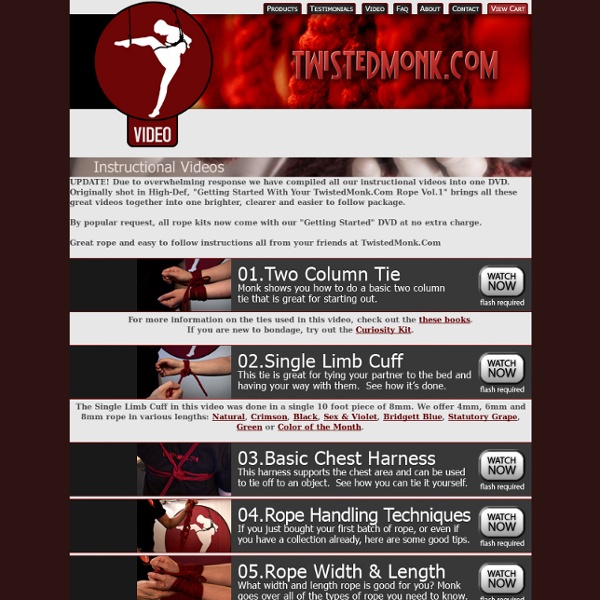



Lewbari Hip Harness Permalink: Codes: Rope Suspension Models: Mick Luvbight This is Mick Luvbight's variant of Lew Rubens' Lewbari™ Hip Harness. THEORY: This is a hip harness rope tie used for suspension. The thigh bands are below the crotch to avoid pressure on the femoral artery (reducing the chance of Harness Hang Syndrome). Although we'll show the handles being tied on the back of the body for a face-down suspension, the same tie can be used to make handles on the front of the body for a face-up suspension or on the side of the hip for a sideways suspension. Web site contents Copyright © 2003-2013 by Mick Luvbight.
Shibari Nation Both natural fibre ropes, and synthetic ropes can be used for bondage, though each has their own properties and may be more suitable in certain situations. In the images on this website, hemp and jute ropes are most commonly used, with nylon being used for photoshoots involving water. Natural fibre ropes: Natural fibre ropes are twisted, rather than braided, and are preferred by some simply due to the aesthetically pleasing marks left on the skin after being tied. Hemp: Hemp fibres come from various strains of the Cannabis sativa plant, and produce a strong, reasonably soft rope, with high enough friction to hold a knot securely. Jute: Jute fibres are produced from plants in the Corchorus genus. Linen: Linen fibres are produced from the flax plant, (usually Linum usitatissimum).The rope produced is very similar to hemp rope, but tends to be a little softer and 'fluffier', and lacks the distinctive smell of hemp. Synthetic ropes:
Hon Kikkou Hon Kikkou Tortoise Shell Advanced Rope Lesson by Tatu (c) 2001, Revised 2007 Model - "yumi" Photos by Quietmstr (c) 2005 Tatu Publications This is probably one of the loveliest designs to learn. It is called a "Hon Kikkou". Please Note: Unfortunately the word "kikkou" has been misused in the west to describe diamond shaped patterns on the body which would more accurately be called a "hishi". All content & design © 1995-2020, TPPI and its affiliates and assigns and licensors, unless otherwise noted. "DsARts", "The Academy of DsARts", "Academy of D/s Arts, Japanese Rope ARt, and "The ARt of Geisha", "The Geisha Files", "The Way of Rope" are copyright titles, logos and signatures of TPPI. Unauthorized use is a willful infringement upon my rights under 17 U.S.C. All Models are at least 21 years old.
amazon Bondage 101: Two-Column Weave This tutorial describes an easy and versatile two-column tie. A two-column tie is any tie that ties two parallel things together, such as two arms, or two legs, or an arm to a leg, or a leg to a post, or whatever. This particular two-column tie is very fast and simple, looks gorgeous, and requires no knots. While it looks complicated, this is actually a very easy tie to learn. You can learn to do it in about five minutes, and it only takes a minute or two to put on. You can also use this as a single-column tie, for example, on one arm or one leg. Making the tie This two-column tie starts, as most ties do, by finding the middle of the rope. For the purposes of this tutorial, I'm going to show you how to tie your partner's arms together with a no-knot two-column weave. Fold the rope at the middle. The concept of a "loop" is important here, and one we'll keep coming back to. So. Don't pull the rope tight. You're just going to keep doing this over and over. And that's it. Going further